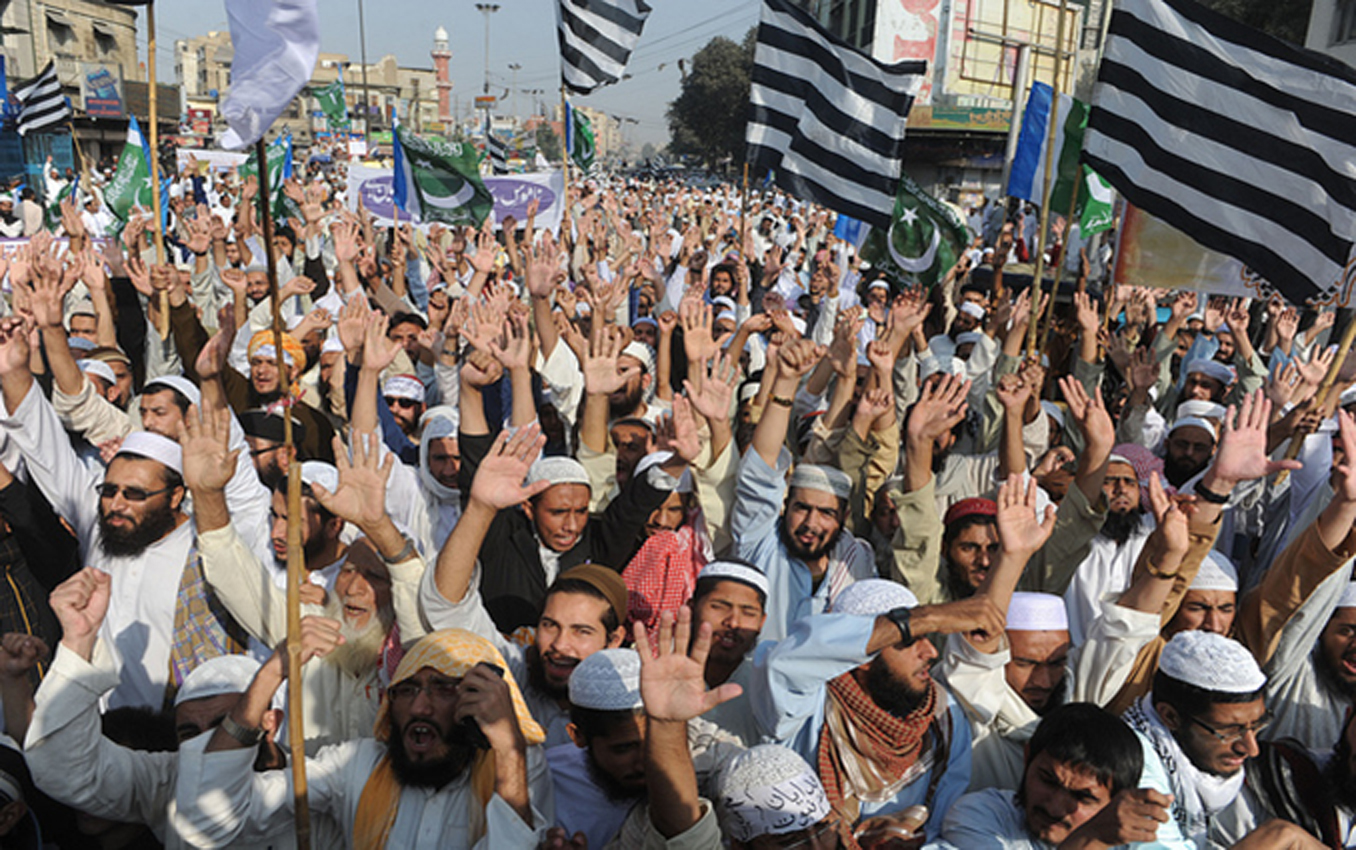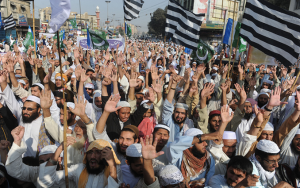The former Governor of Punjab Salmaan Taseer was murdered by a religious extremist. The late Governor sought to initiate positive changes in Pakistan’s controversial blasphemy law, introduced by late General Zia-ul-Haq, the former military dictator who sent populist President Zulfiqar Ali Bhutto to the gallows and used Islam to legitimize his autocratic rule. Urdu press coverage of the bigotry and harangues of his murderer, Mumtaz Qadri (one of the late governor’s guards) led to a frenzy of demands for his acquittal.
The Blasphemy law needs to be reformed for two reasons:
1. It is used for vendetta, mostly to target marginalized individuals, especially from among minorities, in settling private scores. The strict punishment for blasphemy is the death penalty, even when the evidence is ambiguous.
2. It is a manmade law and like any other law should be open to debate leading to amendment.
Introduced by the British in 1860, the blasphemy laws applied to all religions. Their purpose at the time was to prevent communal conflicts in British India. The laws lay dormant for an extended period only to be reborn in a severe and ambiguous form in the 1980s during General Zia’s regime in Pakistan. In 1986, Section 295-C legitimized the death penalty for anybody who was accused of disrespecting the prophet of Islam. From the 1980s onward, there was a rampant increase in reported blasphemy cases. Blasphemy became a popular excuse to settle petty scores and most of the accused ended up in jail for long periods. Religious zealots in Pakistan, in the same way as Judeo-Christian fanatics in USA, whip up hate campaigns in the name of evangelism, and manage to exert tremendous pressure on lower courts and the police to indict and punish alleged blasphemers without due process of law. Since it was difficult to prove allegations of blasphemy, most cases took a long time to be settled, and in almost all cases the accused were either acquitted by the superior courts or punished by death.
Aasia Bibi, a Christian laborer and mother of five, was sentenced to death under the Blasphemy Law by a court in Nankana Sahib, Punjab in November 2010. She was the first woman to be sentenced to death under the blasphemy law (Pakistan Penal Code). The allegation against her was that she had blasphemed against Prophet Muhammad during a quarrel with fellow Muslim women laborers. A mercy petition was prepared by Governor Taseer for President Asif Ali Zardari on November 20 2010 during his visit to the district jail. He stated at a press conference that she had been wrongly accused of the crime. Following Taseer’s appeal for mercy, a mob rioted outside the Governor House in Lahore, burning his effigy and calling for his death.
President Zardari at first said that he might pardon the Christian woman if she had been wrongly convicted. However, on the advice of his legal advisors, he stalled his decision, allowing the superior courts to review the conviction. The issue became a “bone of contention between the government and the mullah” (Guardian, U.K.) A section of the Pakistani media played a highly provocative role by presenting Taseer as an accomplice in blasphemy. The governor’s actual role was to stand up for minority rights and officially enter his plea against the misuse of the law. The Urdu print media, in particular, joined the chorus of religious parties in a vicious campaign that culminated in the brutal assassination of Governor Taseer. On January 4 2011, Taseer’s security guard, 26-year-old Mumtaz Qadri, fired his gun at the Governor 29 times, shooting him dead. He surrendered himself to the police saying: “Salmaan Taseer is a blasphemer and this is the punishment for a blasphemer.” (BBC)
In the past, religious parties played on the emotive issues of blasphemy and the finality of the prophet-hood of Prophet Mohammed for public appeal to suit their political ends. Often the Urdu media played into the clergy’s hands and created a public frenzy. Blasphemy cases have always been exploited in Pakistan by the vernacular media, which tended to ignore the persecution of minorities. Moeed Pirzada has noted how an otherwise robust media ignored the story of an alleged Hindu blasphemer, Jagdeesh Kumar, who was brutally murdered by a Muslim mob in Karachi’s industrial area (Daily Times, April 19 2008). Analyst Ziauddin found that the Pakistani press was suffering from a patent majoritarian bias.
The mullah and the media nexus over blasphemy has developed because the blasphemy story is a selling point. The Aasia blasphemy case provided yet another opportunity, this time for the electronic media, to exploit the public’s wild imagination through primetime television slots hungry for ratings in absurd competition. The religious right in politics is understandably determined to defend the gains it made in its collaboration with General Zia, who used Islamization as a pretext to prolong his authoritarian regime. General Zia won over the religious right by offering them the trophies of the blasphemy law and other controversial legislations, such as the Hudood Ordinance and Qanoon-i-Shahadat order. Successive legislatures dispensed with many amendments brought into the Constitution by successive military rulers but could not remove the controversial Islamic provisions. Pressure from the religious right and a scoop-hungry media playing to their tune ruled the roost.
Indeed the media spin over Governor Taseer’s initiative to obtain pardon for the wrongly convicted Aasia followed the familiar pattern of newsrooms racing to create news-stories rather than follow news events. Taseer’s official request for the due process of law, albeit with the fanfare of a press briefing, was deliberately turned into a “hot” story. The newsrooms ignored Aasia Bibi’s side of the story, her declarations that she respected the Prophet, and her plea that she had been falsely accused and jailed. Instead, a large segment of the media chose to present Aasia as a blasphemer deserving death who was being protected by a liberal, nonconformist governor. In addition, television channels covered long, passionate speeches by religious and nonreligious leaders inciting Muslims to take revenge on those who dared to show disrespect for the Prophet or even call for due process of law for anyone accused of blasphemy.
Sensationalizing the issue for their mass readership, Pakistan’s Urdu newspapers took the lead in farming negative rhetoric against Taseer and played a pivotal role in inciting the people to violence. The public reaction, along with TV channels, was initially divided. A group of civil society protestors in Lahore rallied on November 21 2010 demanding Aasia’s release. Yet only a few days later, during a more charged public rally in the same city, an Aalmi Tanzim Ahle Sunnat leader, Pir Muhammad Afzal Qadri, appealed to Chief Justice Iftikhar Chaudhry to take suo moto notice against
Governor Taseer for defending the “blasphemer” Aasia Bibi. Threats were hurled at government functionaries, parliamentarians, and religious scholars who had expressed their reservations about the death sentence awarded to Aasia Bibi. Most Urdu editorials were vociferous in framing Taseer as a blasphemer. He was compared to his father M. D. Taseer, who had actively participated in the burial of Ghazi Ilam Din, a Muslim convicted of murdering a Hindu accused of blasphemy in the 1920s. Repeated columns raised the question: How could the son of an aashiq-e-rasool (lover of the prophet) support a blaspheming woman?
Numerous articles in the Urdu press were bent upon discrediting Taseer for having brought shame to the Muslim ummah (brotherhood). A section of the Urdu press deliberately distorted Taseer’s argument for procedural revisions necessary to stop misuse of the blasphemy law. Sherry Rehman, a leading parliamentarian of the ruling Pakistan People’s Party and Asma Jehangir, president of the Supreme Court Bar Association, were castigated for expressing their dissent over the misuse of the blasphemy law. On the other hand, the English press, with its limited readership, garnered very little public attention on behalf of its advocacy for corrections, as the law was flawed.
Taseer’s preliminary news conference favoring Aasia’s release was presented on November 20 2010, and was covered in television as part of general news segments. Eventually the TV coverage followed the sensationalism of the print media. Javed Chaudhary, in the introduction to his program “Kal Tak” (aired on November 22 2010 on Express News), attempted to present Taseer as a governor bent on pleasing the Pope, America, and other western countries by supporting a Christian woman. He obtained, however, a broad spectrum of opinion in his choice of guests, inviting Shahbaz Bhatti, the federal minister for minorities, Dr Atiq-ur-Rehman, secretary general of Jamiat Ulema-e-Islam (F), and Tahira Abdullah, a human rights activist, onto his panel. He pursued a provocative style and did not balance his questions, but he offered equal space for a fair debate among the guests in his program. Atiq-ur-Rehman defended the blasphemy law and Tahira Abdullah argued that it has been reduced to a political tool for many political players. Shahbaz Bhatti, by giving facts about the misuse of the law, brought some sense of objectivity and rationality to the discussion.
Anchor Najam Sethi’s program on the blasphemy law (aired on November 22 2010 on Dunya TV) was more of a balanced debate. Apart from his researched analysis, his program included a news package on the Aasia Bibi case, a short interview with Governor Taseer, a brief chronology of the blasphemy law, and contributions by the Punjab law minister Rana Sana Ullah and religious scholar Javed Ghamdi. His documentation displayed objectivity, and his analysis was candid.
On November 23 2010, Express TV took up the Taseer/Aasia story and provided the religious clergy extra space to denounce the governor. Mubashar Luqman’s program “Point Blank” included Hafiz Butt (Jamaat-e-Islami), Allama Abbas Kashmiri, and Mufti Abdul Kareem (Jamaat-e-Ahlesunnat, Pakistan) as guests. Luqman himself, though, blamed his guests for turning a legal debate into a religious issue, but it did not have much effect.
One of the most controversial talk shows was conducted by Samaa TV anchor Meher Bokhari on November 25 2010. Bokhari conducted a satellite interview with Governor Taseer on Aasia Bibi. She venomously put Taseer in the dock and narrowed her questioning line to bypass the merit of the case itself and seek the governor’s answer to vilifications in the Urdu press and to insinuate a betrayal of his father’s ideals. Most of the time, Bokhari either put words in his mouth with the intention of distorting his points, or refused to let him finish by rudely cutting him off.
She shouted at him thrice and once waved a supposedly secret document in his face, bluffing and confusing the TV audience with a hint of dark suspicion. In yet another program, Bokhari went to the extent of admirably comparing Taseer’s murderer Mumtaz Qadri to the “heroic” legacy of Ghazi Ilam Din.
Pakistan’s sensationalist news channels certainly played a dubious part in blurring the distinction between law and emotion in the public mind, and whipping up hostility toward Taseer. The lead part was taken by Meher Bokhari. As Huma Yusuf noted in the Dawn, January 31, 2011: “Pakistan’s electronic media industry is known for creating an atmosphere of perpetual crisis. Bokhari is particularly accused by many critics, especially among the new media, of fanning the hysteria over the Taseer/Aasia story that eventually led to the governor’s tragic death. By crossing all ethical limits, Bokhari led the hysteric misrepresentation of the case for the gutter media to follow, inviting mass critique on popular blogs.”
Indeed, breathing in the atmosphere created by some television channels and most Urdu newspapers, the Taseer/Aasia discussion found space in the social media on various blogs, Twitter, and Facebook. Anchors like Meher Bokhari were discredited on blogs such as Kala Kawa and Café Pyala. But she was hailed on websites such as pkpolitics.com for the same show: “Shahid Masood and Kamran Khan are losing their rating. So today I will only give 1/10 to Kamran Khan and 0/10 to Dr Shahid Masood. I will give Mehar Bokhari 10/10 because she tackled Salman Taseer very well.”
It is possible that innumerable blog posts hailing Bokhari’s instigating style and the outspoken Taseer’s frankness may have attracted higher ratings. The media was quick to realize that the audience was not warming up to balanced talk shows, but applauding Bokhari who was appealing to deeply-rooted religious prejudices. The objective media appears thereafter to have turned tail and given space to a hate campaign. Amplified negative coverage on channels such as Royal TV, Apna, and Waqt, where numerous budding journalists tried to copy Bokhari’s passionate indignation, brought about the doom of a right-minded governor. The Mardoch syndrome in U.K. could not have such tragic victims as were targeted in Pakistan in the increasingly competitive media environment, in which newsmen and TV anchors consider it their journalistic prerogative to selectively pick on misinformation or themselves raise suspicions without proper research or evidence, and hype malicious stories only to boost their sales. TV anchors in Pakistan come largely from the Urdu press. As such, they tend to be oriented toward rightwing conservatism like Fox News in the USA. Some of them have developed or style of ‘hard talk’ that amount to heckling of guests without giving them adequate time for rebuttal. Their ‘unmasking’ technique may or may not earn them media star status, the damage they may do to causes or persons are enormous, particularly when vulnerable communities are involved.
On the blasphemy issue, audience response to Bokhari exemplifies the black magic of media power. Some analysts surmise that the Pakistani media was deliberately developing an audience with a specific extremist mindset, espousing sensationalism and leaving little room for object-ivity. Private channels may be unwittingly orchestrating doctrinaire campaigns of religious extremism by the manner in which they selectively seek and broadcast public opinion samplings.
Some anchors look toward a market that is more responsive to sensationalism and scandal-mongering. They do not care about possible traffic consequences of their unscrupulous media activism. The Domino effect of glorifying Mumtaz Qadri, the assassin of Governor Taseer, on the screen as a “hero of faith” was rolling social media applause and a Facebook page saluting him for “heroic” defiance of the law by stabbing his master in the back, so to say, in a cowardly act of assassination.
Governor Taseer was not the only victim of Blasphemy Law frenzy. Lahore High Court judge Justice Arif Iqbal Husain Bhatti, who acquitted two Christian youths, Salamat Masih and Rehmat Masih on charges of blasphemy, was assassinated in 1997. Minorities’ voices had been so suf-focated that, in May 1998, a Catholic bishop, John Joseph, shot himself dead as a protest. Former strongman President Pervez Musharraf too had to give in to the threats of the mullah. He recalled a directive that would have looked into complaints of misuse of the blasphemy law.
As the politicians lack necessary moral courage to take a firm stand on the issue, it is up to the civil society and a strong human rights movement to turn the table on the fatal peddlers of religious bigotry and uphold the age of reason. ■
——-—————————————
Zainul Abedin is an Urdu litterateur and correspondent of the Pakistani Daily Jang.
Translated from Urdu




This weekend, the king of Saudi Arabia announced that Women in Saudi Arabia will now be able to vote. In this day and age, that’s rather disgraceful that laws like this really still exist. No offence to Islam or to Muslims, but this is very stupid to abide by these ancient laws. If the whole world followed laws of the ancient Christian world, Texas would be crucifying its death sentence inmates.
Comments are closed.